An Analysis of Leadership's Effect on Staff Commitment in SMEs
VerifiedAdded on 2023/01/06
|60
|9096
|59
Project
AI Summary
This project investigates the critical role of leadership in fostering staff commitment within Small and Medium Enterprises (SMEs). The study begins with an introduction outlining the significance of effective leadership for SME success, particularly in enhancing employee motivation and reducing turnover. A comprehensive literature review explores leadership theories, leadership styles within SMEs, and factors influencing staff commitment, including organizational and individual aspects. The research employs a quantitative methodology, utilizing questionnaires to gather primary data from SME employees. The findings, presented through data analysis and discussion, reveal the direct impact of leadership on employee satisfaction, motivation, and overall commitment. The project concludes with recommendations for improving leadership practices to boost employee engagement and retention, ultimately contributing to SME growth and economic contribution. The project underscores the importance of leadership in creating a positive work environment that enhances employee commitment and organizational performance.

Agreement with Dissertation’s instruction,
title and purpose
1
title and purpose
1
Paraphrase This Document
Need a fresh take? Get an instant paraphrase of this document with our AI Paraphraser
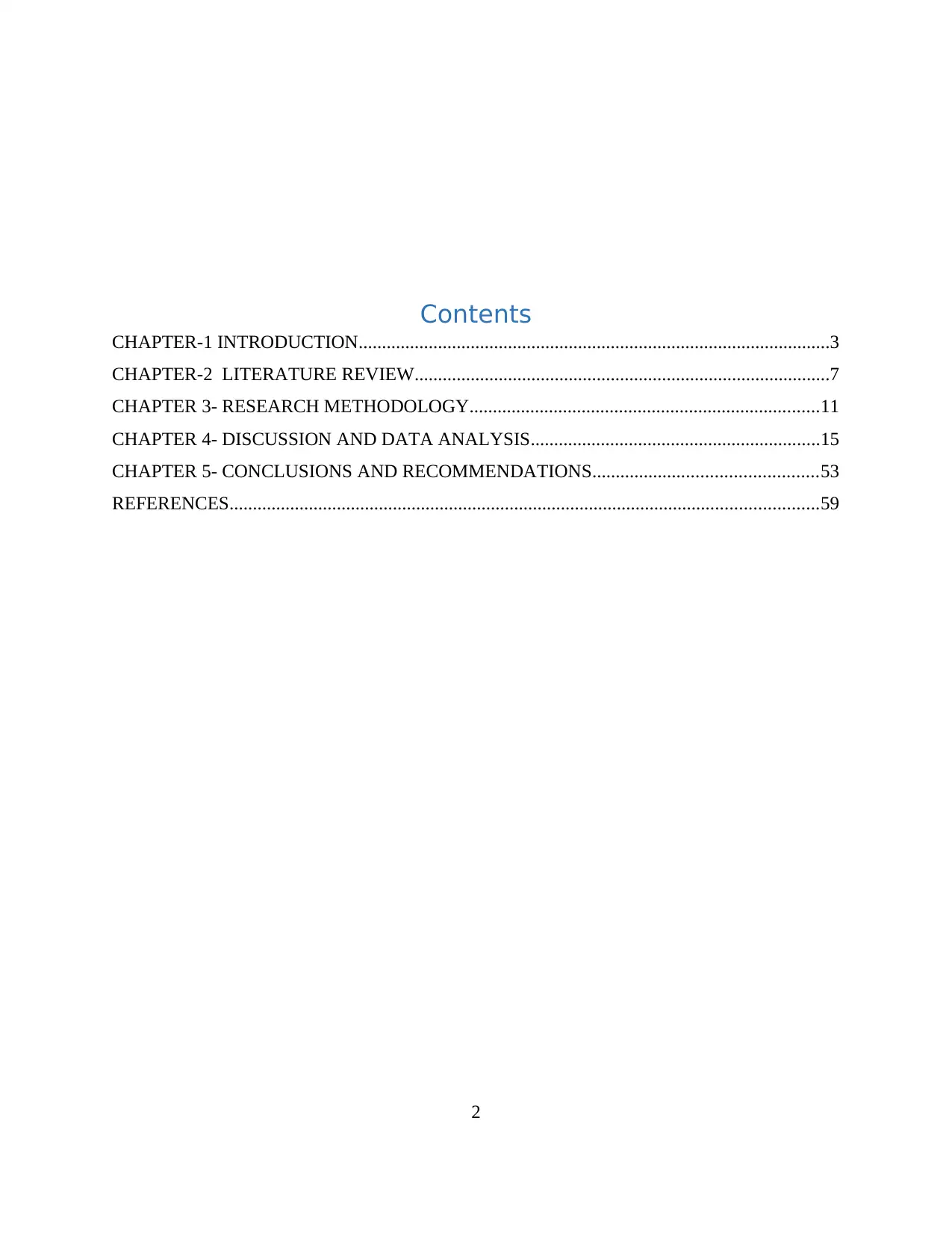
Contents
CHAPTER-1 INTRODUCTION.....................................................................................................3
CHAPTER-2 LITERATURE REVIEW.........................................................................................7
CHAPTER 3- RESEARCH METHODOLOGY...........................................................................11
CHAPTER 4- DISCUSSION AND DATA ANALYSIS..............................................................15
CHAPTER 5- CONCLUSIONS AND RECOMMENDATIONS................................................53
REFERENCES..............................................................................................................................59
2
CHAPTER-1 INTRODUCTION.....................................................................................................3
CHAPTER-2 LITERATURE REVIEW.........................................................................................7
CHAPTER 3- RESEARCH METHODOLOGY...........................................................................11
CHAPTER 4- DISCUSSION AND DATA ANALYSIS..............................................................15
CHAPTER 5- CONCLUSIONS AND RECOMMENDATIONS................................................53
REFERENCES..............................................................................................................................59
2
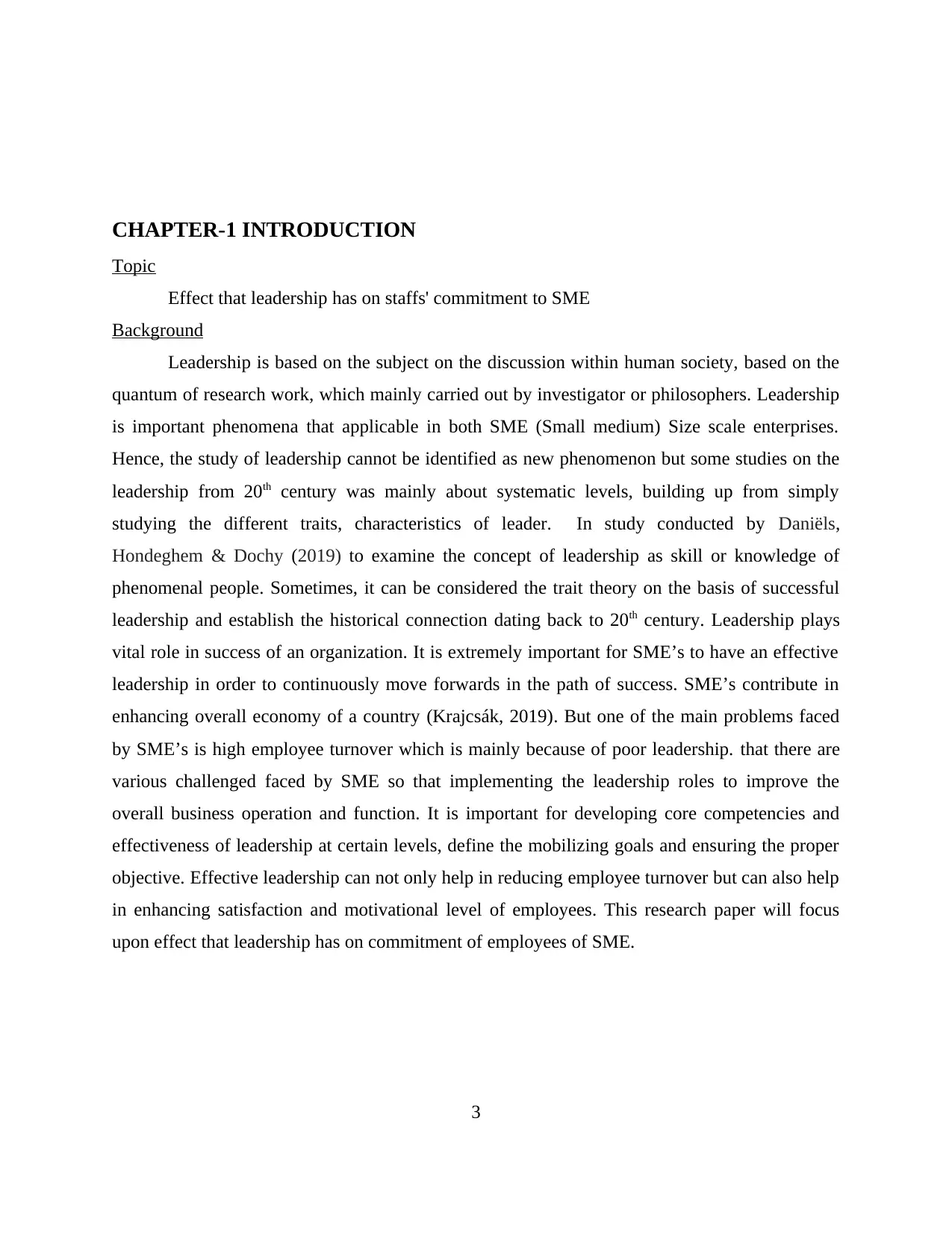
CHAPTER-1 INTRODUCTION
Topic
Effect that leadership has on staffs' commitment to SME
Background
Leadership is based on the subject on the discussion within human society, based on the
quantum of research work, which mainly carried out by investigator or philosophers. Leadership
is important phenomena that applicable in both SME (Small medium) Size scale enterprises.
Hence, the study of leadership cannot be identified as new phenomenon but some studies on the
leadership from 20th century was mainly about systematic levels, building up from simply
studying the different traits, characteristics of leader. In study conducted by Daniëls,
Hondeghem & Dochy (2019) to examine the concept of leadership as skill or knowledge of
phenomenal people. Sometimes, it can be considered the trait theory on the basis of successful
leadership and establish the historical connection dating back to 20th century. Leadership plays
vital role in success of an organization. It is extremely important for SME’s to have an effective
leadership in order to continuously move forwards in the path of success. SME’s contribute in
enhancing overall economy of a country (Krajcsák, 2019). But one of the main problems faced
by SME’s is high employee turnover which is mainly because of poor leadership. that there are
various challenged faced by SME so that implementing the leadership roles to improve the
overall business operation and function. It is important for developing core competencies and
effectiveness of leadership at certain levels, define the mobilizing goals and ensuring the proper
objective. Effective leadership can not only help in reducing employee turnover but can also help
in enhancing satisfaction and motivational level of employees. This research paper will focus
upon effect that leadership has on commitment of employees of SME.
3
Topic
Effect that leadership has on staffs' commitment to SME
Background
Leadership is based on the subject on the discussion within human society, based on the
quantum of research work, which mainly carried out by investigator or philosophers. Leadership
is important phenomena that applicable in both SME (Small medium) Size scale enterprises.
Hence, the study of leadership cannot be identified as new phenomenon but some studies on the
leadership from 20th century was mainly about systematic levels, building up from simply
studying the different traits, characteristics of leader. In study conducted by Daniëls,
Hondeghem & Dochy (2019) to examine the concept of leadership as skill or knowledge of
phenomenal people. Sometimes, it can be considered the trait theory on the basis of successful
leadership and establish the historical connection dating back to 20th century. Leadership plays
vital role in success of an organization. It is extremely important for SME’s to have an effective
leadership in order to continuously move forwards in the path of success. SME’s contribute in
enhancing overall economy of a country (Krajcsák, 2019). But one of the main problems faced
by SME’s is high employee turnover which is mainly because of poor leadership. that there are
various challenged faced by SME so that implementing the leadership roles to improve the
overall business operation and function. It is important for developing core competencies and
effectiveness of leadership at certain levels, define the mobilizing goals and ensuring the proper
objective. Effective leadership can not only help in reducing employee turnover but can also help
in enhancing satisfaction and motivational level of employees. This research paper will focus
upon effect that leadership has on commitment of employees of SME.
3
⊘ This is a preview!⊘
Do you want full access?
Subscribe today to unlock all pages.

Trusted by 1+ million students worldwide
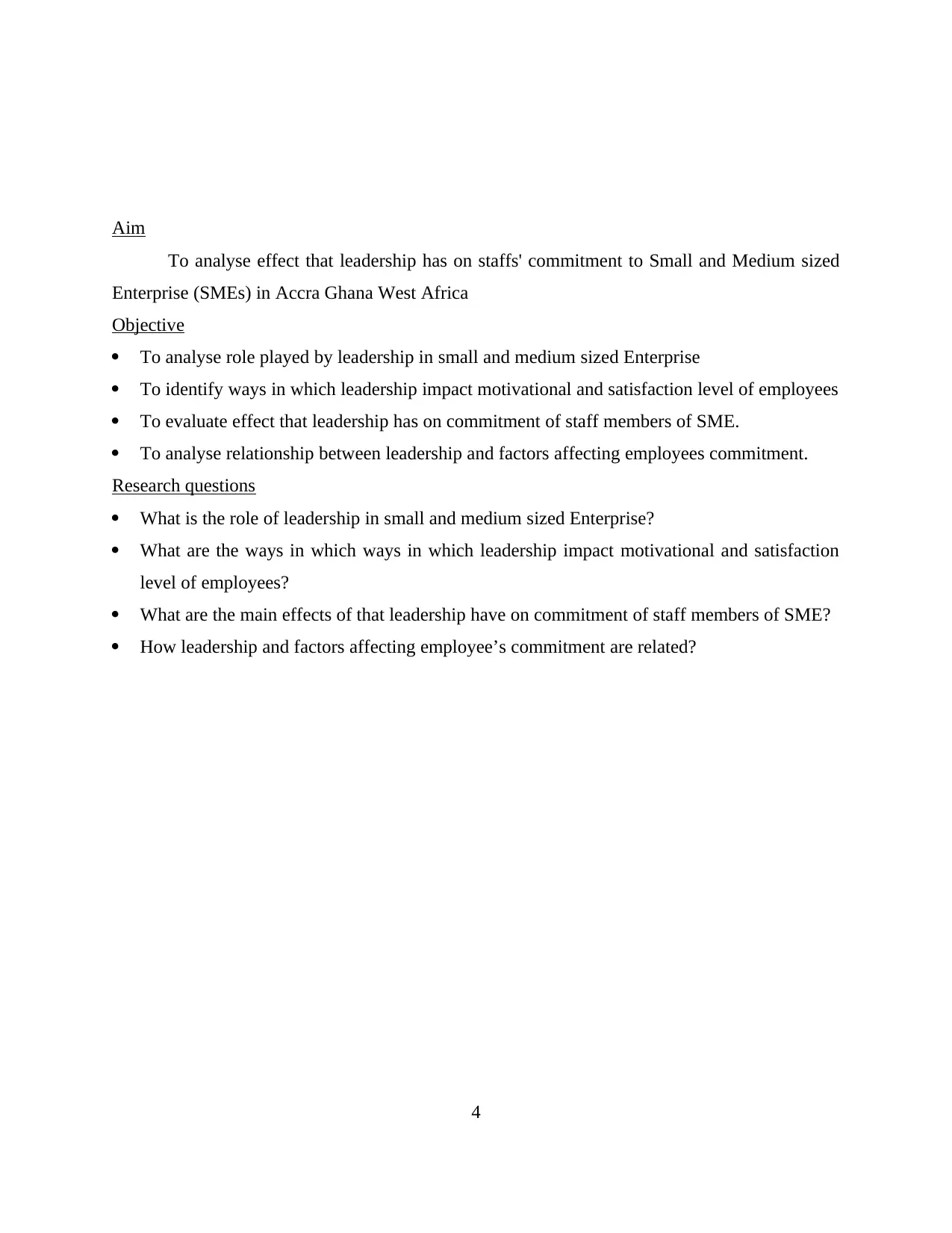
Aim
To analyse effect that leadership has on staffs' commitment to Small and Medium sized
Enterprise (SMEs) in Accra Ghana West Africa
Objective
To analyse role played by leadership in small and medium sized Enterprise
To identify ways in which leadership impact motivational and satisfaction level of employees
To evaluate effect that leadership has on commitment of staff members of SME.
To analyse relationship between leadership and factors affecting employees commitment.
Research questions
What is the role of leadership in small and medium sized Enterprise?
What are the ways in which ways in which leadership impact motivational and satisfaction
level of employees?
What are the main effects of that leadership have on commitment of staff members of SME?
How leadership and factors affecting employee’s commitment are related?
4
To analyse effect that leadership has on staffs' commitment to Small and Medium sized
Enterprise (SMEs) in Accra Ghana West Africa
Objective
To analyse role played by leadership in small and medium sized Enterprise
To identify ways in which leadership impact motivational and satisfaction level of employees
To evaluate effect that leadership has on commitment of staff members of SME.
To analyse relationship between leadership and factors affecting employees commitment.
Research questions
What is the role of leadership in small and medium sized Enterprise?
What are the ways in which ways in which leadership impact motivational and satisfaction
level of employees?
What are the main effects of that leadership have on commitment of staff members of SME?
How leadership and factors affecting employee’s commitment are related?
4
Paraphrase This Document
Need a fresh take? Get an instant paraphrase of this document with our AI Paraphraser
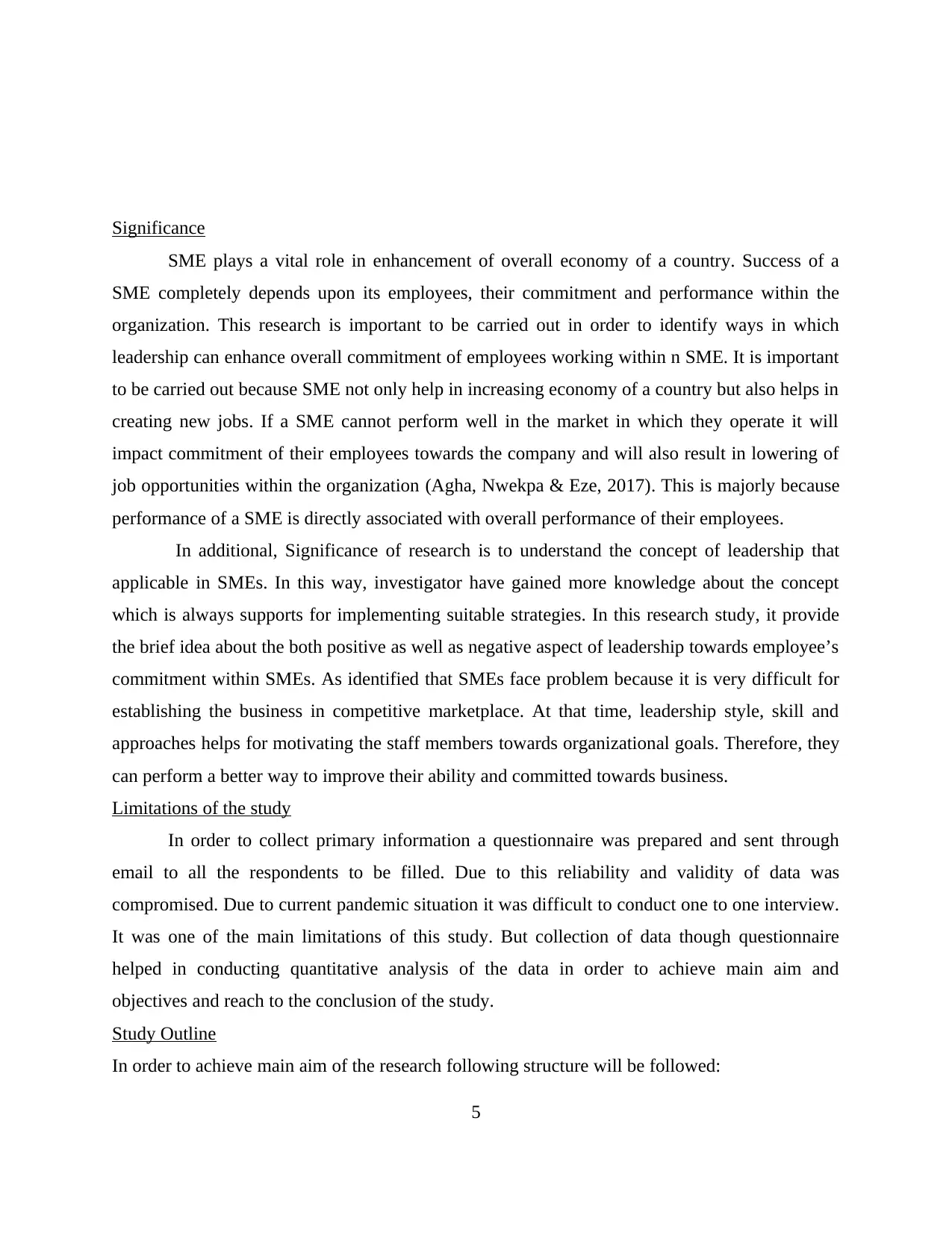
Significance
SME plays a vital role in enhancement of overall economy of a country. Success of a
SME completely depends upon its employees, their commitment and performance within the
organization. This research is important to be carried out in order to identify ways in which
leadership can enhance overall commitment of employees working within n SME. It is important
to be carried out because SME not only help in increasing economy of a country but also helps in
creating new jobs. If a SME cannot perform well in the market in which they operate it will
impact commitment of their employees towards the company and will also result in lowering of
job opportunities within the organization (Agha, Nwekpa & Eze, 2017). This is majorly because
performance of a SME is directly associated with overall performance of their employees.
In additional, Significance of research is to understand the concept of leadership that
applicable in SMEs. In this way, investigator have gained more knowledge about the concept
which is always supports for implementing suitable strategies. In this research study, it provide
the brief idea about the both positive as well as negative aspect of leadership towards employee’s
commitment within SMEs. As identified that SMEs face problem because it is very difficult for
establishing the business in competitive marketplace. At that time, leadership style, skill and
approaches helps for motivating the staff members towards organizational goals. Therefore, they
can perform a better way to improve their ability and committed towards business.
Limitations of the study
In order to collect primary information a questionnaire was prepared and sent through
email to all the respondents to be filled. Due to this reliability and validity of data was
compromised. Due to current pandemic situation it was difficult to conduct one to one interview.
It was one of the main limitations of this study. But collection of data though questionnaire
helped in conducting quantitative analysis of the data in order to achieve main aim and
objectives and reach to the conclusion of the study.
Study Outline
In order to achieve main aim of the research following structure will be followed:
5
SME plays a vital role in enhancement of overall economy of a country. Success of a
SME completely depends upon its employees, their commitment and performance within the
organization. This research is important to be carried out in order to identify ways in which
leadership can enhance overall commitment of employees working within n SME. It is important
to be carried out because SME not only help in increasing economy of a country but also helps in
creating new jobs. If a SME cannot perform well in the market in which they operate it will
impact commitment of their employees towards the company and will also result in lowering of
job opportunities within the organization (Agha, Nwekpa & Eze, 2017). This is majorly because
performance of a SME is directly associated with overall performance of their employees.
In additional, Significance of research is to understand the concept of leadership that
applicable in SMEs. In this way, investigator have gained more knowledge about the concept
which is always supports for implementing suitable strategies. In this research study, it provide
the brief idea about the both positive as well as negative aspect of leadership towards employee’s
commitment within SMEs. As identified that SMEs face problem because it is very difficult for
establishing the business in competitive marketplace. At that time, leadership style, skill and
approaches helps for motivating the staff members towards organizational goals. Therefore, they
can perform a better way to improve their ability and committed towards business.
Limitations of the study
In order to collect primary information a questionnaire was prepared and sent through
email to all the respondents to be filled. Due to this reliability and validity of data was
compromised. Due to current pandemic situation it was difficult to conduct one to one interview.
It was one of the main limitations of this study. But collection of data though questionnaire
helped in conducting quantitative analysis of the data in order to achieve main aim and
objectives and reach to the conclusion of the study.
Study Outline
In order to achieve main aim of the research following structure will be followed:
5
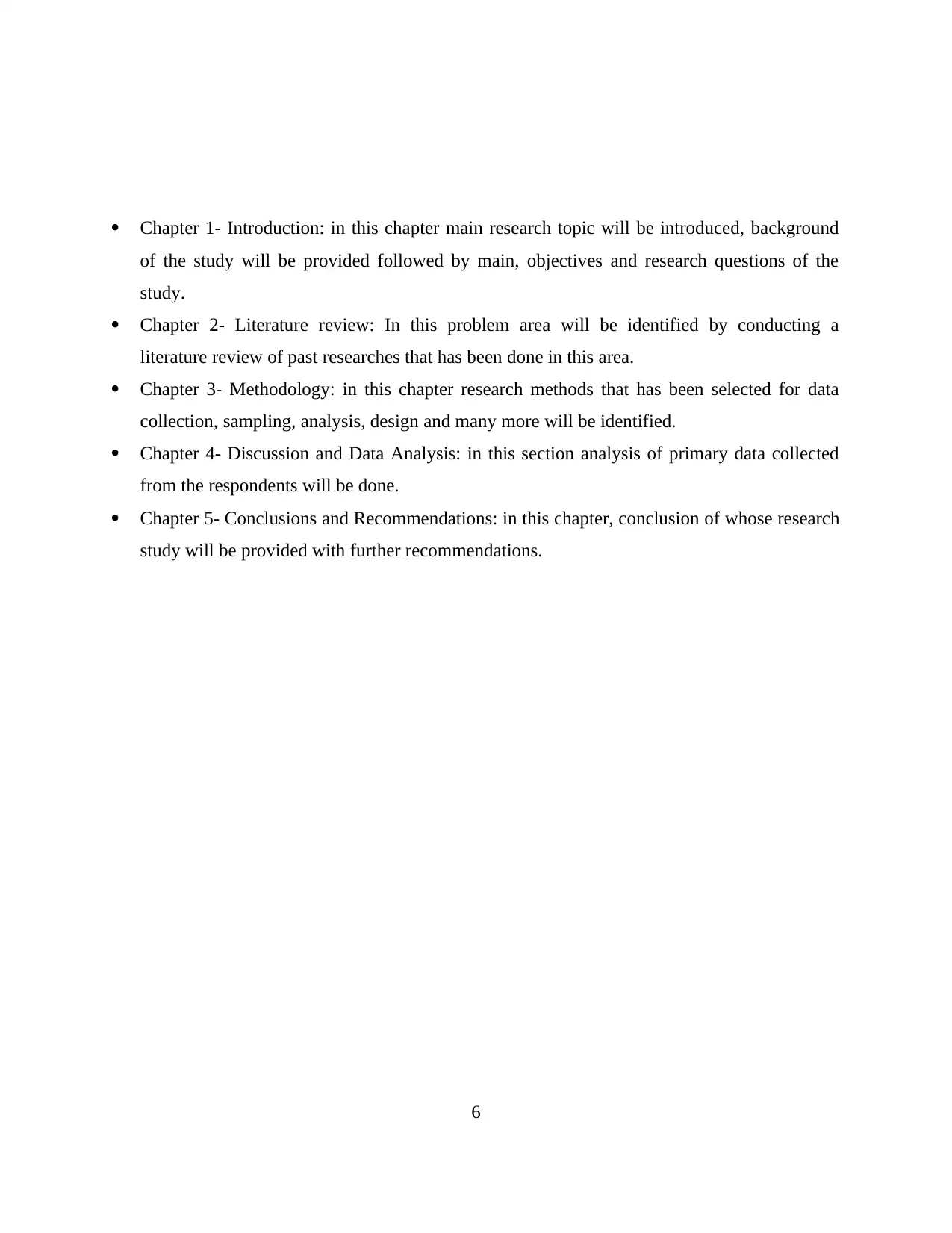
Chapter 1- Introduction: in this chapter main research topic will be introduced, background
of the study will be provided followed by main, objectives and research questions of the
study.
Chapter 2- Literature review: In this problem area will be identified by conducting a
literature review of past researches that has been done in this area.
Chapter 3- Methodology: in this chapter research methods that has been selected for data
collection, sampling, analysis, design and many more will be identified.
Chapter 4- Discussion and Data Analysis: in this section analysis of primary data collected
from the respondents will be done.
Chapter 5- Conclusions and Recommendations: in this chapter, conclusion of whose research
study will be provided with further recommendations.
6
of the study will be provided followed by main, objectives and research questions of the
study.
Chapter 2- Literature review: In this problem area will be identified by conducting a
literature review of past researches that has been done in this area.
Chapter 3- Methodology: in this chapter research methods that has been selected for data
collection, sampling, analysis, design and many more will be identified.
Chapter 4- Discussion and Data Analysis: in this section analysis of primary data collected
from the respondents will be done.
Chapter 5- Conclusions and Recommendations: in this chapter, conclusion of whose research
study will be provided with further recommendations.
6
⊘ This is a preview!⊘
Do you want full access?
Subscribe today to unlock all pages.

Trusted by 1+ million students worldwide
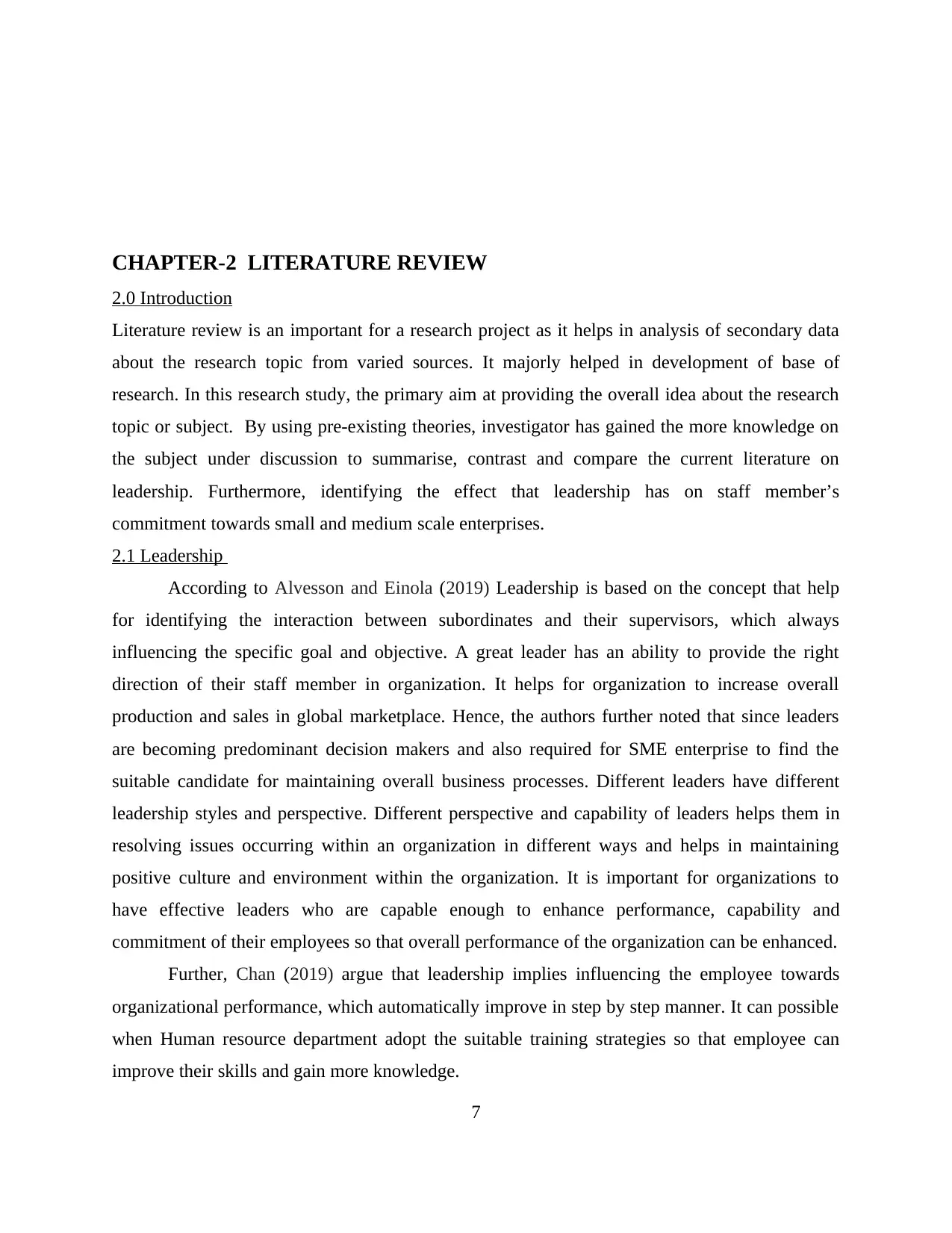
CHAPTER-2 LITERATURE REVIEW
2.0 Introduction
Literature review is an important for a research project as it helps in analysis of secondary data
about the research topic from varied sources. It majorly helped in development of base of
research. In this research study, the primary aim at providing the overall idea about the research
topic or subject. By using pre-existing theories, investigator has gained the more knowledge on
the subject under discussion to summarise, contrast and compare the current literature on
leadership. Furthermore, identifying the effect that leadership has on staff member’s
commitment towards small and medium scale enterprises.
2.1 Leadership
According to Alvesson and Einola (2019) Leadership is based on the concept that help
for identifying the interaction between subordinates and their supervisors, which always
influencing the specific goal and objective. A great leader has an ability to provide the right
direction of their staff member in organization. It helps for organization to increase overall
production and sales in global marketplace. Hence, the authors further noted that since leaders
are becoming predominant decision makers and also required for SME enterprise to find the
suitable candidate for maintaining overall business processes. Different leaders have different
leadership styles and perspective. Different perspective and capability of leaders helps them in
resolving issues occurring within an organization in different ways and helps in maintaining
positive culture and environment within the organization. It is important for organizations to
have effective leaders who are capable enough to enhance performance, capability and
commitment of their employees so that overall performance of the organization can be enhanced.
Further, Chan (2019) argue that leadership implies influencing the employee towards
organizational performance, which automatically improve in step by step manner. It can possible
when Human resource department adopt the suitable training strategies so that employee can
improve their skills and gain more knowledge.
7
2.0 Introduction
Literature review is an important for a research project as it helps in analysis of secondary data
about the research topic from varied sources. It majorly helped in development of base of
research. In this research study, the primary aim at providing the overall idea about the research
topic or subject. By using pre-existing theories, investigator has gained the more knowledge on
the subject under discussion to summarise, contrast and compare the current literature on
leadership. Furthermore, identifying the effect that leadership has on staff member’s
commitment towards small and medium scale enterprises.
2.1 Leadership
According to Alvesson and Einola (2019) Leadership is based on the concept that help
for identifying the interaction between subordinates and their supervisors, which always
influencing the specific goal and objective. A great leader has an ability to provide the right
direction of their staff member in organization. It helps for organization to increase overall
production and sales in global marketplace. Hence, the authors further noted that since leaders
are becoming predominant decision makers and also required for SME enterprise to find the
suitable candidate for maintaining overall business processes. Different leaders have different
leadership styles and perspective. Different perspective and capability of leaders helps them in
resolving issues occurring within an organization in different ways and helps in maintaining
positive culture and environment within the organization. It is important for organizations to
have effective leaders who are capable enough to enhance performance, capability and
commitment of their employees so that overall performance of the organization can be enhanced.
Further, Chan (2019) argue that leadership implies influencing the employee towards
organizational performance, which automatically improve in step by step manner. It can possible
when Human resource department adopt the suitable training strategies so that employee can
improve their skills and gain more knowledge.
7
Paraphrase This Document
Need a fresh take? Get an instant paraphrase of this document with our AI Paraphraser
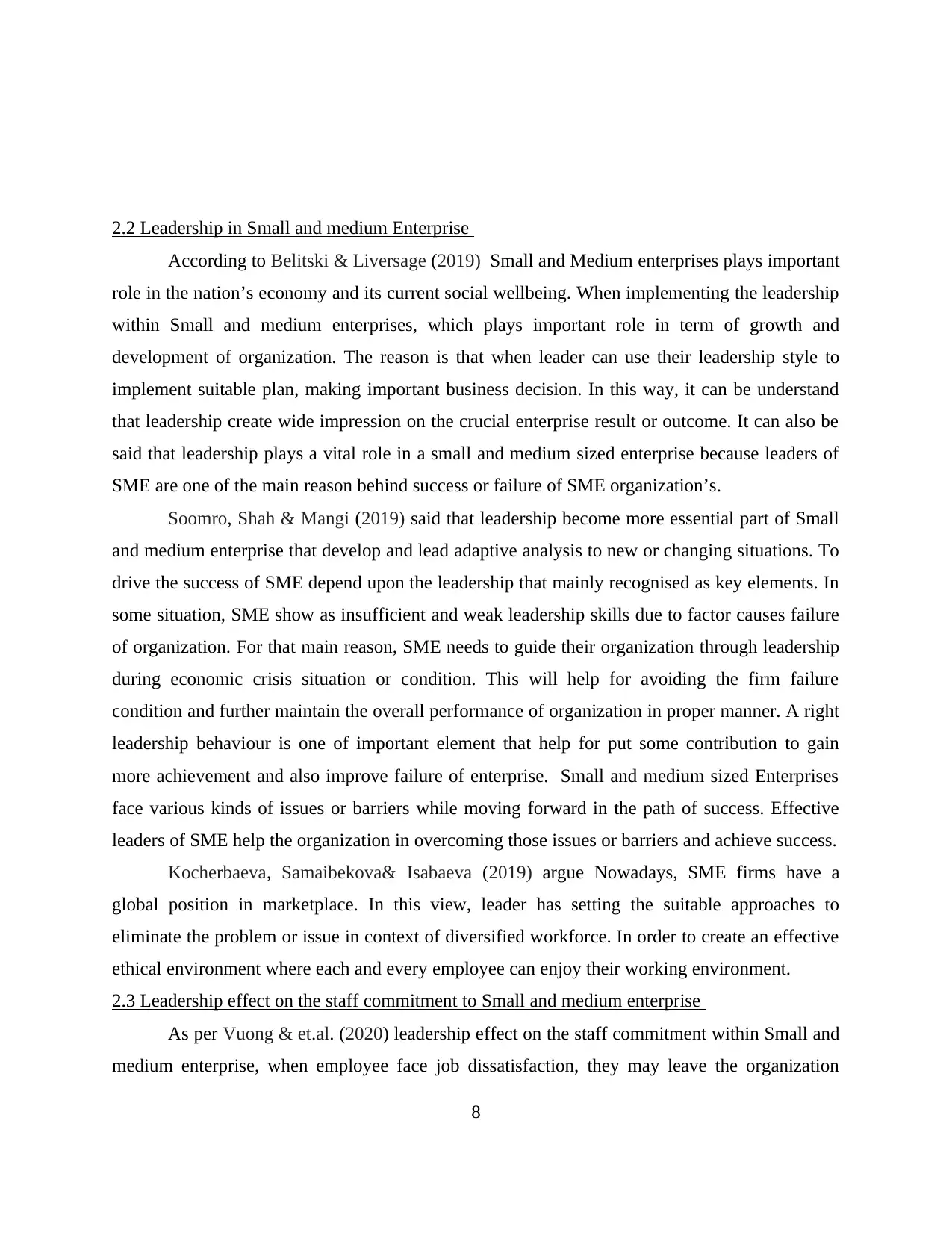
2.2 Leadership in Small and medium Enterprise
According to Belitski & Liversage (2019) Small and Medium enterprises plays important
role in the nation’s economy and its current social wellbeing. When implementing the leadership
within Small and medium enterprises, which plays important role in term of growth and
development of organization. The reason is that when leader can use their leadership style to
implement suitable plan, making important business decision. In this way, it can be understand
that leadership create wide impression on the crucial enterprise result or outcome. It can also be
said that leadership plays a vital role in a small and medium sized enterprise because leaders of
SME are one of the main reason behind success or failure of SME organization’s.
Soomro, Shah & Mangi (2019) said that leadership become more essential part of Small
and medium enterprise that develop and lead adaptive analysis to new or changing situations. To
drive the success of SME depend upon the leadership that mainly recognised as key elements. In
some situation, SME show as insufficient and weak leadership skills due to factor causes failure
of organization. For that main reason, SME needs to guide their organization through leadership
during economic crisis situation or condition. This will help for avoiding the firm failure
condition and further maintain the overall performance of organization in proper manner. A right
leadership behaviour is one of important element that help for put some contribution to gain
more achievement and also improve failure of enterprise. Small and medium sized Enterprises
face various kinds of issues or barriers while moving forward in the path of success. Effective
leaders of SME help the organization in overcoming those issues or barriers and achieve success.
Kocherbaeva, Samaibekova& Isabaeva (2019) argue Nowadays, SME firms have a
global position in marketplace. In this view, leader has setting the suitable approaches to
eliminate the problem or issue in context of diversified workforce. In order to create an effective
ethical environment where each and every employee can enjoy their working environment.
2.3 Leadership effect on the staff commitment to Small and medium enterprise
As per Vuong & et.al. (2020) leadership effect on the staff commitment within Small and
medium enterprise, when employee face job dissatisfaction, they may leave the organization
8
According to Belitski & Liversage (2019) Small and Medium enterprises plays important
role in the nation’s economy and its current social wellbeing. When implementing the leadership
within Small and medium enterprises, which plays important role in term of growth and
development of organization. The reason is that when leader can use their leadership style to
implement suitable plan, making important business decision. In this way, it can be understand
that leadership create wide impression on the crucial enterprise result or outcome. It can also be
said that leadership plays a vital role in a small and medium sized enterprise because leaders of
SME are one of the main reason behind success or failure of SME organization’s.
Soomro, Shah & Mangi (2019) said that leadership become more essential part of Small
and medium enterprise that develop and lead adaptive analysis to new or changing situations. To
drive the success of SME depend upon the leadership that mainly recognised as key elements. In
some situation, SME show as insufficient and weak leadership skills due to factor causes failure
of organization. For that main reason, SME needs to guide their organization through leadership
during economic crisis situation or condition. This will help for avoiding the firm failure
condition and further maintain the overall performance of organization in proper manner. A right
leadership behaviour is one of important element that help for put some contribution to gain
more achievement and also improve failure of enterprise. Small and medium sized Enterprises
face various kinds of issues or barriers while moving forward in the path of success. Effective
leaders of SME help the organization in overcoming those issues or barriers and achieve success.
Kocherbaeva, Samaibekova& Isabaeva (2019) argue Nowadays, SME firms have a
global position in marketplace. In this view, leader has setting the suitable approaches to
eliminate the problem or issue in context of diversified workforce. In order to create an effective
ethical environment where each and every employee can enjoy their working environment.
2.3 Leadership effect on the staff commitment to Small and medium enterprise
As per Vuong & et.al. (2020) leadership effect on the staff commitment within Small and
medium enterprise, when employee face job dissatisfaction, they may leave the organization
8
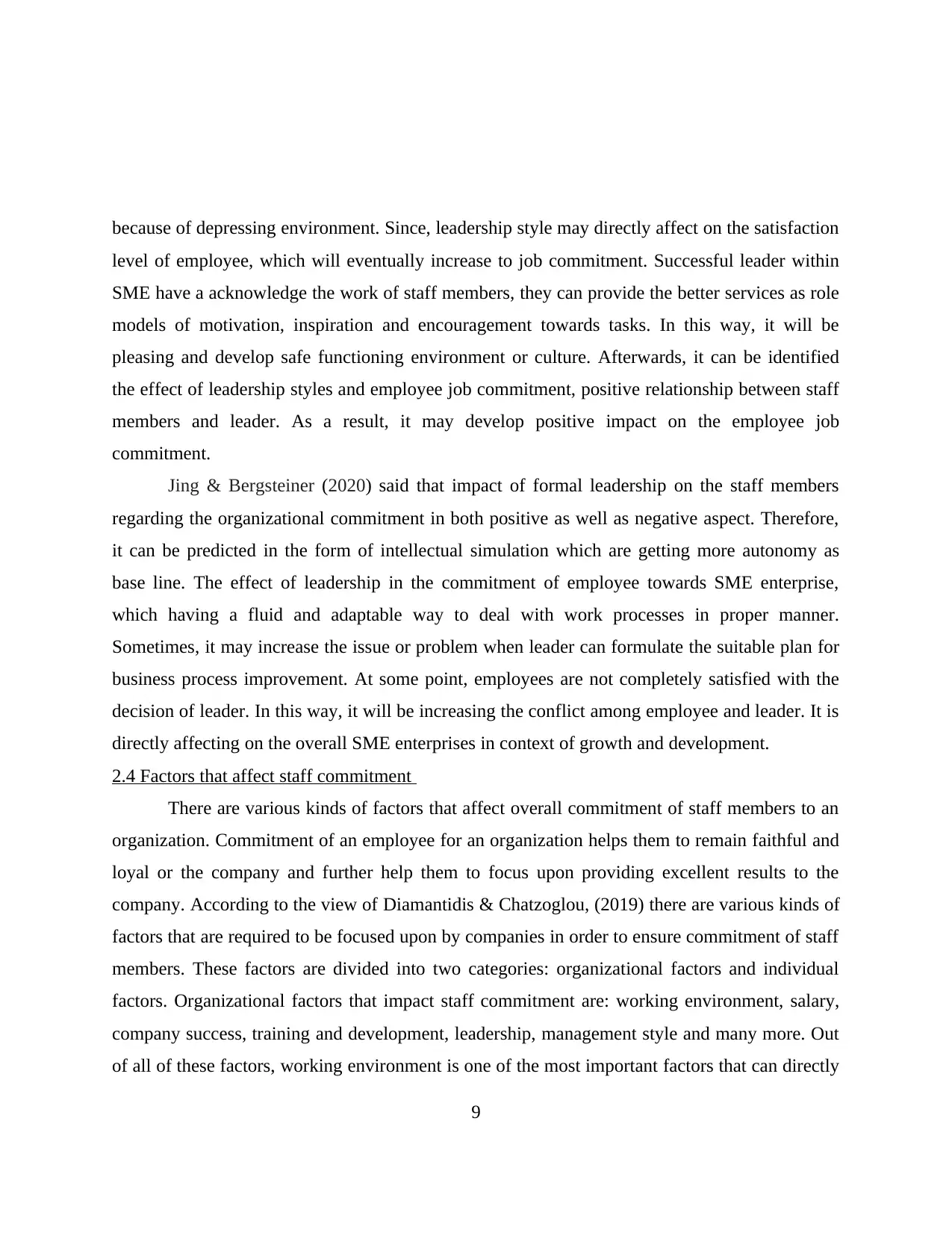
because of depressing environment. Since, leadership style may directly affect on the satisfaction
level of employee, which will eventually increase to job commitment. Successful leader within
SME have a acknowledge the work of staff members, they can provide the better services as role
models of motivation, inspiration and encouragement towards tasks. In this way, it will be
pleasing and develop safe functioning environment or culture. Afterwards, it can be identified
the effect of leadership styles and employee job commitment, positive relationship between staff
members and leader. As a result, it may develop positive impact on the employee job
commitment.
Jing & Bergsteiner (2020) said that impact of formal leadership on the staff members
regarding the organizational commitment in both positive as well as negative aspect. Therefore,
it can be predicted in the form of intellectual simulation which are getting more autonomy as
base line. The effect of leadership in the commitment of employee towards SME enterprise,
which having a fluid and adaptable way to deal with work processes in proper manner.
Sometimes, it may increase the issue or problem when leader can formulate the suitable plan for
business process improvement. At some point, employees are not completely satisfied with the
decision of leader. In this way, it will be increasing the conflict among employee and leader. It is
directly affecting on the overall SME enterprises in context of growth and development.
2.4 Factors that affect staff commitment
There are various kinds of factors that affect overall commitment of staff members to an
organization. Commitment of an employee for an organization helps them to remain faithful and
loyal or the company and further help them to focus upon providing excellent results to the
company. According to the view of Diamantidis & Chatzoglou, (2019) there are various kinds of
factors that are required to be focused upon by companies in order to ensure commitment of staff
members. These factors are divided into two categories: organizational factors and individual
factors. Organizational factors that impact staff commitment are: working environment, salary,
company success, training and development, leadership, management style and many more. Out
of all of these factors, working environment is one of the most important factors that can directly
9
level of employee, which will eventually increase to job commitment. Successful leader within
SME have a acknowledge the work of staff members, they can provide the better services as role
models of motivation, inspiration and encouragement towards tasks. In this way, it will be
pleasing and develop safe functioning environment or culture. Afterwards, it can be identified
the effect of leadership styles and employee job commitment, positive relationship between staff
members and leader. As a result, it may develop positive impact on the employee job
commitment.
Jing & Bergsteiner (2020) said that impact of formal leadership on the staff members
regarding the organizational commitment in both positive as well as negative aspect. Therefore,
it can be predicted in the form of intellectual simulation which are getting more autonomy as
base line. The effect of leadership in the commitment of employee towards SME enterprise,
which having a fluid and adaptable way to deal with work processes in proper manner.
Sometimes, it may increase the issue or problem when leader can formulate the suitable plan for
business process improvement. At some point, employees are not completely satisfied with the
decision of leader. In this way, it will be increasing the conflict among employee and leader. It is
directly affecting on the overall SME enterprises in context of growth and development.
2.4 Factors that affect staff commitment
There are various kinds of factors that affect overall commitment of staff members to an
organization. Commitment of an employee for an organization helps them to remain faithful and
loyal or the company and further help them to focus upon providing excellent results to the
company. According to the view of Diamantidis & Chatzoglou, (2019) there are various kinds of
factors that are required to be focused upon by companies in order to ensure commitment of staff
members. These factors are divided into two categories: organizational factors and individual
factors. Organizational factors that impact staff commitment are: working environment, salary,
company success, training and development, leadership, management style and many more. Out
of all of these factors, working environment is one of the most important factors that can directly
9
⊘ This is a preview!⊘
Do you want full access?
Subscribe today to unlock all pages.

Trusted by 1+ million students worldwide
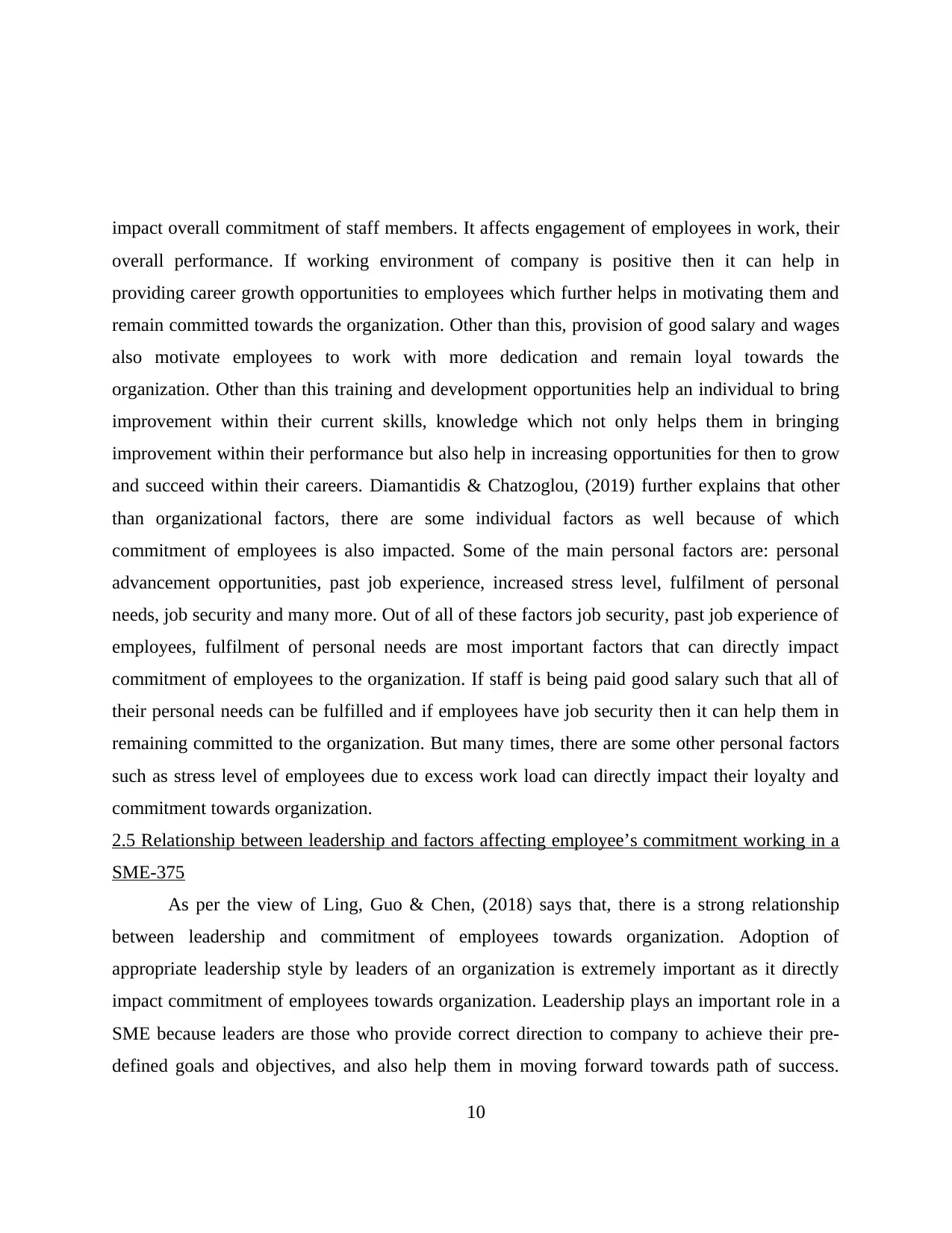
impact overall commitment of staff members. It affects engagement of employees in work, their
overall performance. If working environment of company is positive then it can help in
providing career growth opportunities to employees which further helps in motivating them and
remain committed towards the organization. Other than this, provision of good salary and wages
also motivate employees to work with more dedication and remain loyal towards the
organization. Other than this training and development opportunities help an individual to bring
improvement within their current skills, knowledge which not only helps them in bringing
improvement within their performance but also help in increasing opportunities for then to grow
and succeed within their careers. Diamantidis & Chatzoglou, (2019) further explains that other
than organizational factors, there are some individual factors as well because of which
commitment of employees is also impacted. Some of the main personal factors are: personal
advancement opportunities, past job experience, increased stress level, fulfilment of personal
needs, job security and many more. Out of all of these factors job security, past job experience of
employees, fulfilment of personal needs are most important factors that can directly impact
commitment of employees to the organization. If staff is being paid good salary such that all of
their personal needs can be fulfilled and if employees have job security then it can help them in
remaining committed to the organization. But many times, there are some other personal factors
such as stress level of employees due to excess work load can directly impact their loyalty and
commitment towards organization.
2.5 Relationship between leadership and factors affecting employee’s commitment working in a
SME-375
As per the view of Ling, Guo & Chen, (2018) says that, there is a strong relationship
between leadership and commitment of employees towards organization. Adoption of
appropriate leadership style by leaders of an organization is extremely important as it directly
impact commitment of employees towards organization. Leadership plays an important role in a
SME because leaders are those who provide correct direction to company to achieve their pre-
defined goals and objectives, and also help them in moving forward towards path of success.
10
overall performance. If working environment of company is positive then it can help in
providing career growth opportunities to employees which further helps in motivating them and
remain committed towards the organization. Other than this, provision of good salary and wages
also motivate employees to work with more dedication and remain loyal towards the
organization. Other than this training and development opportunities help an individual to bring
improvement within their current skills, knowledge which not only helps them in bringing
improvement within their performance but also help in increasing opportunities for then to grow
and succeed within their careers. Diamantidis & Chatzoglou, (2019) further explains that other
than organizational factors, there are some individual factors as well because of which
commitment of employees is also impacted. Some of the main personal factors are: personal
advancement opportunities, past job experience, increased stress level, fulfilment of personal
needs, job security and many more. Out of all of these factors job security, past job experience of
employees, fulfilment of personal needs are most important factors that can directly impact
commitment of employees to the organization. If staff is being paid good salary such that all of
their personal needs can be fulfilled and if employees have job security then it can help them in
remaining committed to the organization. But many times, there are some other personal factors
such as stress level of employees due to excess work load can directly impact their loyalty and
commitment towards organization.
2.5 Relationship between leadership and factors affecting employee’s commitment working in a
SME-375
As per the view of Ling, Guo & Chen, (2018) says that, there is a strong relationship
between leadership and commitment of employees towards organization. Adoption of
appropriate leadership style by leaders of an organization is extremely important as it directly
impact commitment of employees towards organization. Leadership plays an important role in a
SME because leaders are those who provide correct direction to company to achieve their pre-
defined goals and objectives, and also help them in moving forward towards path of success.
10
Paraphrase This Document
Need a fresh take? Get an instant paraphrase of this document with our AI Paraphraser
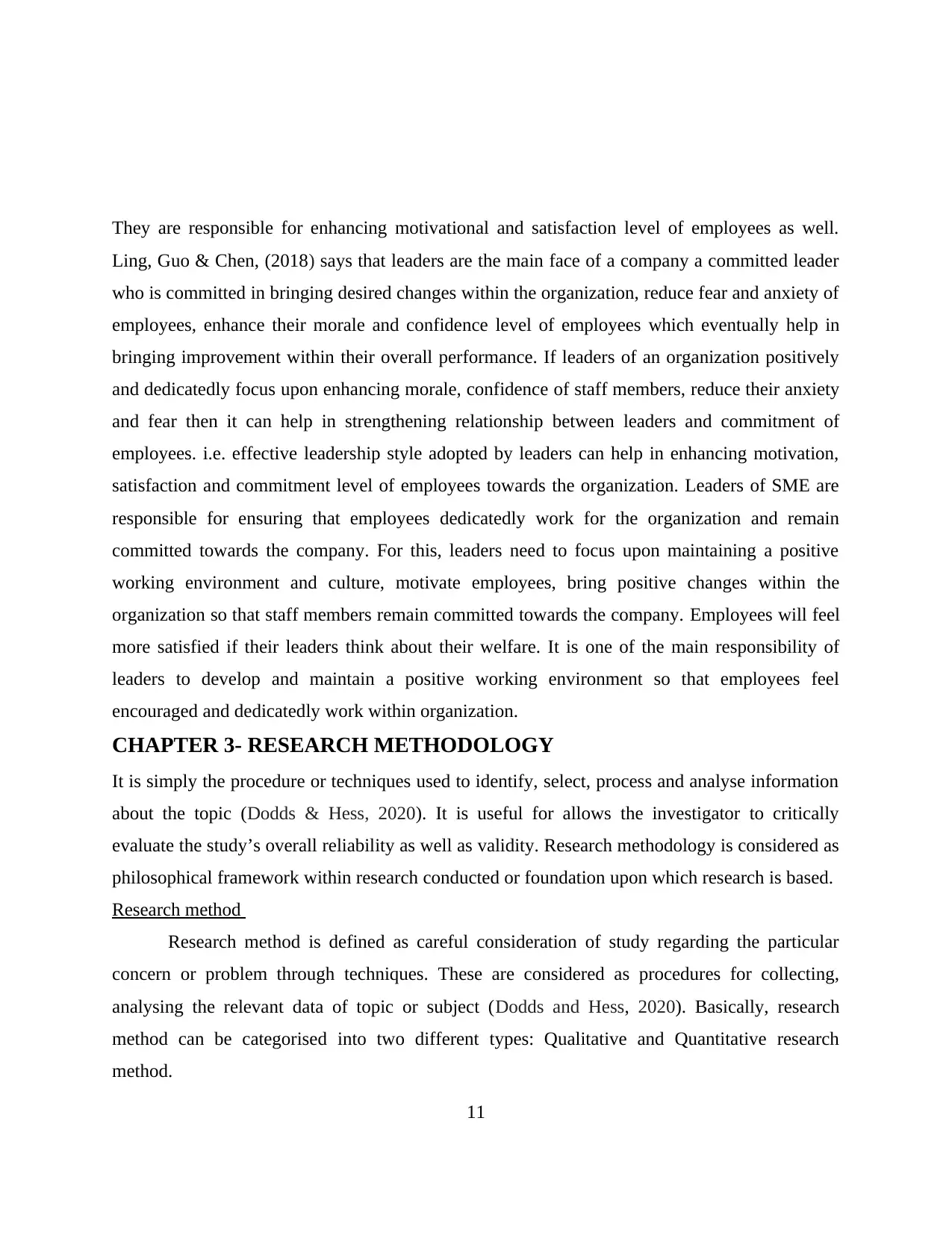
They are responsible for enhancing motivational and satisfaction level of employees as well.
Ling, Guo & Chen, (2018) says that leaders are the main face of a company a committed leader
who is committed in bringing desired changes within the organization, reduce fear and anxiety of
employees, enhance their morale and confidence level of employees which eventually help in
bringing improvement within their overall performance. If leaders of an organization positively
and dedicatedly focus upon enhancing morale, confidence of staff members, reduce their anxiety
and fear then it can help in strengthening relationship between leaders and commitment of
employees. i.e. effective leadership style adopted by leaders can help in enhancing motivation,
satisfaction and commitment level of employees towards the organization. Leaders of SME are
responsible for ensuring that employees dedicatedly work for the organization and remain
committed towards the company. For this, leaders need to focus upon maintaining a positive
working environment and culture, motivate employees, bring positive changes within the
organization so that staff members remain committed towards the company. Employees will feel
more satisfied if their leaders think about their welfare. It is one of the main responsibility of
leaders to develop and maintain a positive working environment so that employees feel
encouraged and dedicatedly work within organization.
CHAPTER 3- RESEARCH METHODOLOGY
It is simply the procedure or techniques used to identify, select, process and analyse information
about the topic (Dodds & Hess, 2020). It is useful for allows the investigator to critically
evaluate the study’s overall reliability as well as validity. Research methodology is considered as
philosophical framework within research conducted or foundation upon which research is based.
Research method
Research method is defined as careful consideration of study regarding the particular
concern or problem through techniques. These are considered as procedures for collecting,
analysing the relevant data of topic or subject (Dodds and Hess, 2020). Basically, research
method can be categorised into two different types: Qualitative and Quantitative research
method.
11
Ling, Guo & Chen, (2018) says that leaders are the main face of a company a committed leader
who is committed in bringing desired changes within the organization, reduce fear and anxiety of
employees, enhance their morale and confidence level of employees which eventually help in
bringing improvement within their overall performance. If leaders of an organization positively
and dedicatedly focus upon enhancing morale, confidence of staff members, reduce their anxiety
and fear then it can help in strengthening relationship between leaders and commitment of
employees. i.e. effective leadership style adopted by leaders can help in enhancing motivation,
satisfaction and commitment level of employees towards the organization. Leaders of SME are
responsible for ensuring that employees dedicatedly work for the organization and remain
committed towards the company. For this, leaders need to focus upon maintaining a positive
working environment and culture, motivate employees, bring positive changes within the
organization so that staff members remain committed towards the company. Employees will feel
more satisfied if their leaders think about their welfare. It is one of the main responsibility of
leaders to develop and maintain a positive working environment so that employees feel
encouraged and dedicatedly work within organization.
CHAPTER 3- RESEARCH METHODOLOGY
It is simply the procedure or techniques used to identify, select, process and analyse information
about the topic (Dodds & Hess, 2020). It is useful for allows the investigator to critically
evaluate the study’s overall reliability as well as validity. Research methodology is considered as
philosophical framework within research conducted or foundation upon which research is based.
Research method
Research method is defined as careful consideration of study regarding the particular
concern or problem through techniques. These are considered as procedures for collecting,
analysing the relevant data of topic or subject (Dodds and Hess, 2020). Basically, research
method can be categorised into two different types: Qualitative and Quantitative research
method.
11
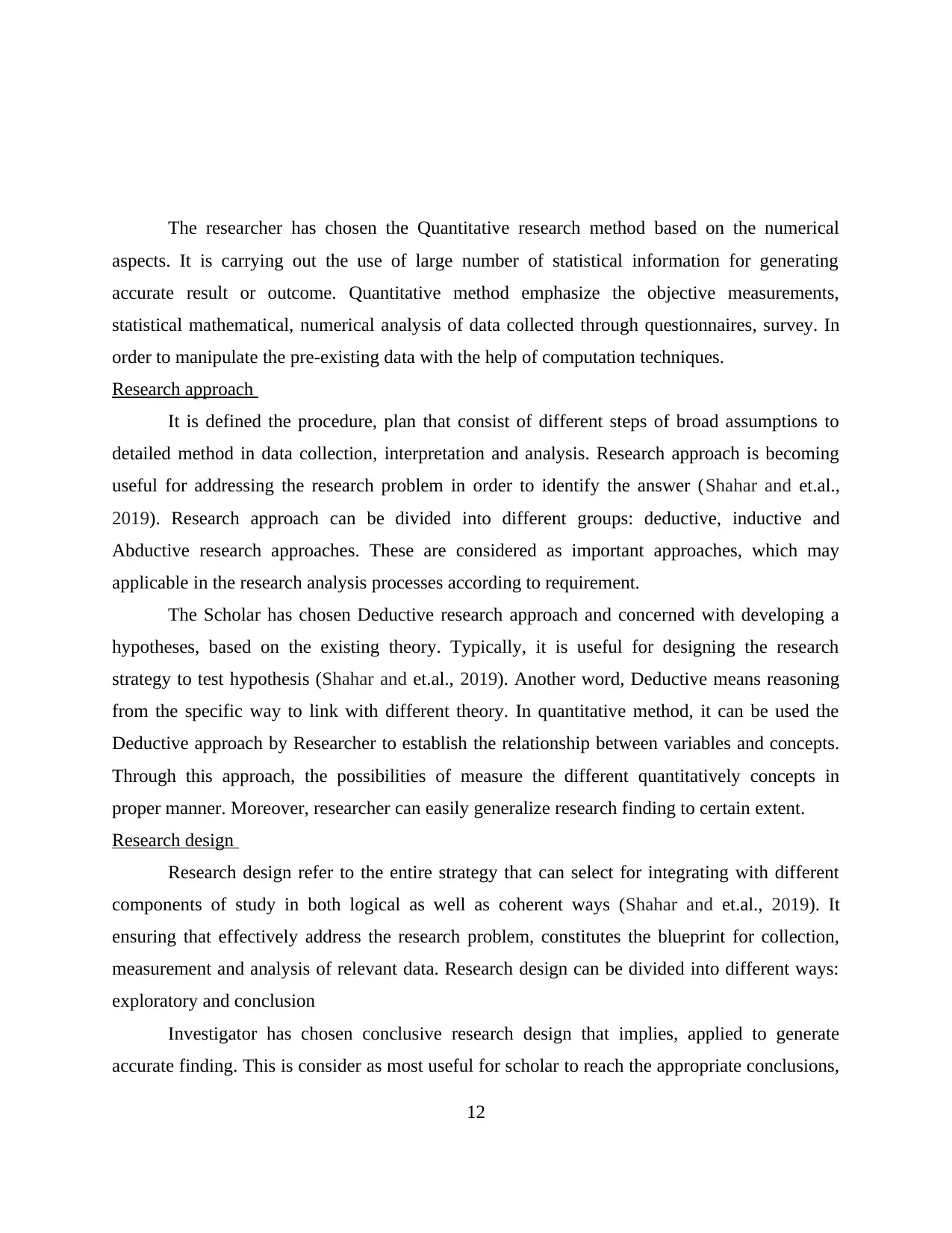
The researcher has chosen the Quantitative research method based on the numerical
aspects. It is carrying out the use of large number of statistical information for generating
accurate result or outcome. Quantitative method emphasize the objective measurements,
statistical mathematical, numerical analysis of data collected through questionnaires, survey. In
order to manipulate the pre-existing data with the help of computation techniques.
Research approach
It is defined the procedure, plan that consist of different steps of broad assumptions to
detailed method in data collection, interpretation and analysis. Research approach is becoming
useful for addressing the research problem in order to identify the answer (Shahar and et.al.,
2019). Research approach can be divided into different groups: deductive, inductive and
Abductive research approaches. These are considered as important approaches, which may
applicable in the research analysis processes according to requirement.
The Scholar has chosen Deductive research approach and concerned with developing a
hypotheses, based on the existing theory. Typically, it is useful for designing the research
strategy to test hypothesis (Shahar and et.al., 2019). Another word, Deductive means reasoning
from the specific way to link with different theory. In quantitative method, it can be used the
Deductive approach by Researcher to establish the relationship between variables and concepts.
Through this approach, the possibilities of measure the different quantitatively concepts in
proper manner. Moreover, researcher can easily generalize research finding to certain extent.
Research design
Research design refer to the entire strategy that can select for integrating with different
components of study in both logical as well as coherent ways (Shahar and et.al., 2019). It
ensuring that effectively address the research problem, constitutes the blueprint for collection,
measurement and analysis of relevant data. Research design can be divided into different ways:
exploratory and conclusion
Investigator has chosen conclusive research design that implies, applied to generate
accurate finding. This is consider as most useful for scholar to reach the appropriate conclusions,
12
aspects. It is carrying out the use of large number of statistical information for generating
accurate result or outcome. Quantitative method emphasize the objective measurements,
statistical mathematical, numerical analysis of data collected through questionnaires, survey. In
order to manipulate the pre-existing data with the help of computation techniques.
Research approach
It is defined the procedure, plan that consist of different steps of broad assumptions to
detailed method in data collection, interpretation and analysis. Research approach is becoming
useful for addressing the research problem in order to identify the answer (Shahar and et.al.,
2019). Research approach can be divided into different groups: deductive, inductive and
Abductive research approaches. These are considered as important approaches, which may
applicable in the research analysis processes according to requirement.
The Scholar has chosen Deductive research approach and concerned with developing a
hypotheses, based on the existing theory. Typically, it is useful for designing the research
strategy to test hypothesis (Shahar and et.al., 2019). Another word, Deductive means reasoning
from the specific way to link with different theory. In quantitative method, it can be used the
Deductive approach by Researcher to establish the relationship between variables and concepts.
Through this approach, the possibilities of measure the different quantitatively concepts in
proper manner. Moreover, researcher can easily generalize research finding to certain extent.
Research design
Research design refer to the entire strategy that can select for integrating with different
components of study in both logical as well as coherent ways (Shahar and et.al., 2019). It
ensuring that effectively address the research problem, constitutes the blueprint for collection,
measurement and analysis of relevant data. Research design can be divided into different ways:
exploratory and conclusion
Investigator has chosen conclusive research design that implies, applied to generate
accurate finding. This is consider as most useful for scholar to reach the appropriate conclusions,
12
⊘ This is a preview!⊘
Do you want full access?
Subscribe today to unlock all pages.

Trusted by 1+ million students worldwide
1 out of 60
Related Documents
Your All-in-One AI-Powered Toolkit for Academic Success.
+13062052269
info@desklib.com
Available 24*7 on WhatsApp / Email
![[object Object]](/_next/static/media/star-bottom.7253800d.svg)
Unlock your academic potential
Copyright © 2020–2025 A2Z Services. All Rights Reserved. Developed and managed by ZUCOL.




